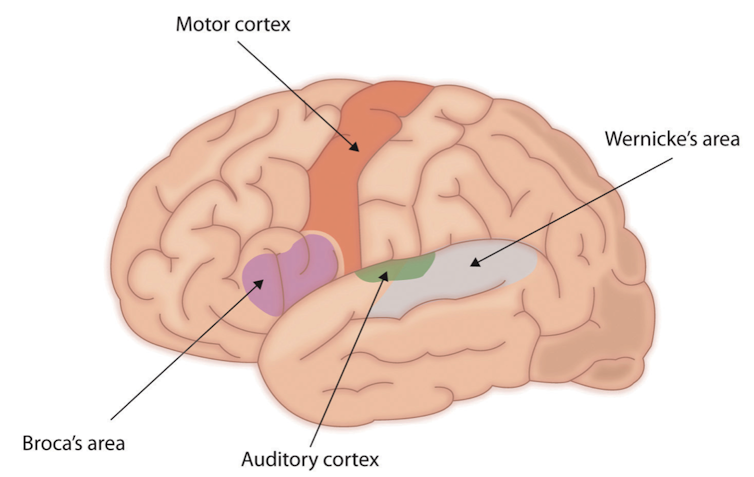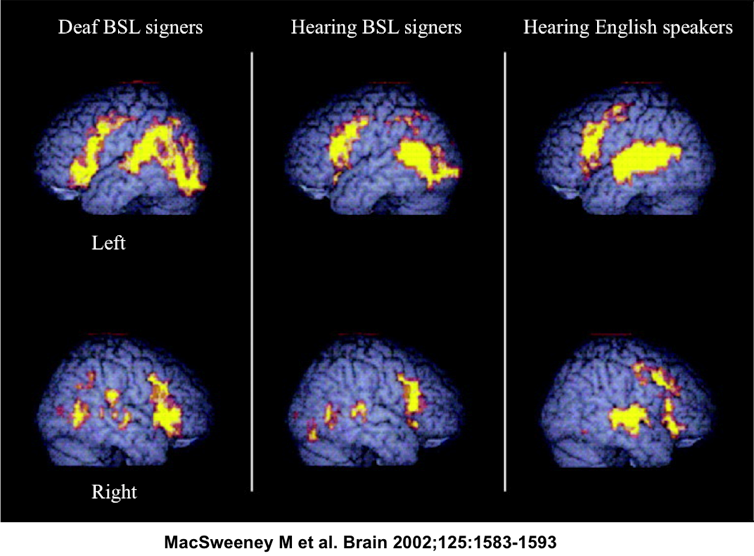what is the significance of brain damage as it pertains to asl?
The world's leading humanoid robot, ASIMO, has recently learnt sign language. The news of this breakthrough came but as I completed Level ane of British Sign Linguistic communication (I dare say it took me longer to master signing than it did the robot!). Every bit a neuroscientist, the feel of learning to sign made me think about how the brain perceives this means of communicating.
For instance, during my training, I constitute that mnemonics greatly simplified my learning process. To sign the color blue you use the fingers of your right manus to rub the back of your left mitt, my uncomplicated mnemonic for this sign being that the veins on the dorsum of our hand announced blue. I was therefore forming an association between the word blue (English), the sign for blue (BSL), and the visual aid that links the ii. However, the 2 languages differ markedly in that one relies on sounds and the other on visual signs.
Do our brains process these languages differently? It seems that for the most office, they don't. And it turns out that brain studies of sign linguistic communication users have helped bust a few myths.
As neuroscience took off, it became fashionable to identify specific regions of the brain that were thought to be responsible for certain skills. Notwithstanding, we at present know that this oversimplification paints simply one-half a movie. Nowhere else is this clearer than in the instance of how human brains perceive language, whether spoken or sign linguistic communication.
The prove for this comes from two kinds of studies: lesion analyses, which examine the functional consequences of damage to brain regions involved in linguistic communication, and neuroimaging, which explores how these regions are engaged in processing language.
Lesions teach new lessons
Early theories of linguistic communication processing pointed to two regions in the left hemisphere of the brain that were idea to be chiefly responsible for producing and understanding spoken linguistic communication – Broca'due south surface area and Wernicke's area.

Impairment to Broca's surface area, which is located almost the part of the motor cortex that controls the rima oris and lips, usually gives rise to difficulties in the production of speech communication. Only this doesn't adversely touch on one's ability to communicate, or understand chat. And then a hearing person with a lesion in Broca'southward area – which tin grade, say, later a stroke – may non exist able to form fluid sentences, simply he or she could employ single words, short phrases, and perhaps nod or shake their head to gesture their responses.
The comprehension of speech, on the other hand, is largely believed to be processed within Wernicke's area, which is located virtually the auditory cortex – the part of the brain that receives signals from the ears. Hearing people with damage to Wernicke's area are usually fluent in producing spoken language, just may brand up words (for instance: "cataloop" for "caterpillar" shown in the video beneath) and speak in long sentences that have no pregnant.
If Broca'south area is involved solely in the production of speech, and Wernicke'due south area in agreement oral communication sounds, so we might wait that visual languages like sign language remain unaffected when these areas are damaged. Simply, surprisingly, they practise not.
One of the seminal studies in this field was by award-winning hubby and wife team Edward Klima and Ursula Bellugi at the Salk Institute. They establish that deaf signers who had lesions in left hemisphere "speech centres" like Broca's and Wernicke's areas produced significantly more sign errors on naming, repetition and sentence-comprehension tasks than signers with damaged correct hemispheres.
The correct hemisphere of the brain is more than involved in visual and spatial functions than the left hemisphere, and this is not to say that the right hemisphere is not at all involved in producing and comprehending sign language. However, these findings verify that despite the differences in modality, signed and spoken languages are similarly afflicted past damage to the left hemisphere of the brain.
Images speak out too
Functional neuroimaging, which can show images of agile regions in the brain, has agreed with lesion studies. Despite the cardinal differences in input or output modes for signed and spoken languages, there are common patterns of brain activation when deafened and hearing people process language.

For instance, Broca's surface area is besides activated when producing signs and Wernicke's area is activated during the perception of sign language.
Most chiefly, these lesion and neuroimaging studies helped clarify two facts. First, that language is non merely limited to hearing and speech, and sign languages are complex linguistic systems candy much similar spoken languages. 2d, it also cemented our growing reservations of the oversimplified theories of language perception. Their involvement in processing sign language meant that we could no longer think of Broca's and Wernicke's areas exclusively as centres for producing spoken language and hearing audio, but rather equally college-order language areas in the brain.
Contrary to the common misconception, there is no universal sign language. According to a recent estimate, there are 138 variations of sign language in the earth today, with structured syntax, grammar, and fifty-fifty regional accents. Information technology is unfortunate then that a pregnant proportion of the global deaf customs is notwithstanding contesting for legal recognition of these languages.
Sign language is sometimes misguidedly looked upon as a "disability" language and simply a visual means of communicating spoken linguistic communication, when it fact its linguistic construction is most entirely independent of spoken linguistic communication. For example, American and British Sign Language are mutually incomprehensible, even though the hearing people of United kingdom of great britain and northern ireland and America predominantly share the same spoken language.
Knowledge of how sign languages are processed in the brain has not only furthered our understanding of the brain itself, but has also played a function in quashing the once widely believed notion that these signs were simply a loose collection of gestures strung together to communicate spoken communication.
Source: https://theconversation.com/what-sign-language-teaches-us-about-the-brain-29628
0 Response to "what is the significance of brain damage as it pertains to asl?"
Post a Comment